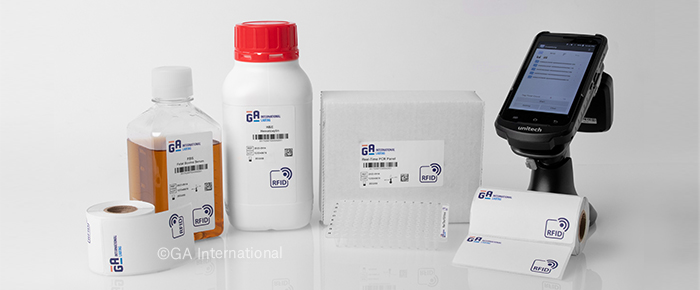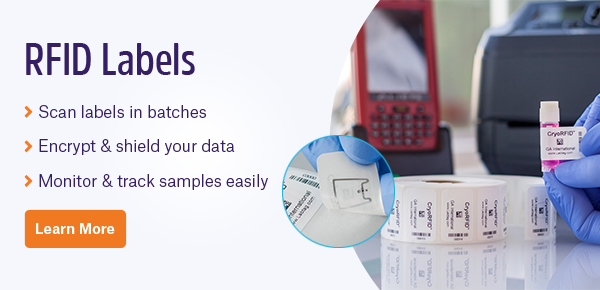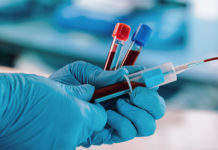
Radio-frequency identification (RFID) has quickly become the trendy new method of identification in bioscience and pharmaceutical labs. While most have adapted RFID labels and tags to identify inventories of specimens and reagents, some are beginning to utilize the technology in novel ways, directly incorporating it into their medical and scientific procedures with the aim of improving readouts and providing better patient care.
Preventative management of cancer1
Lymph node biopsy is an essential part of cancer staging and treatment. Many patients, such as those with breast cancer, require lymph node dissection to remove cancerous tissues. The surgical location is based on a sentinel lymph node biopsy (SLNB), which determines whether the cancer has spread to its hypothetical “first” lymph node. However, before surgery can be performed, these lymph nodes must be labeled using marking devices as clips to inform the surgeon where to operate later.
Clips used in these procedures can include magnetic implants, radioactive iodine seeds, tattoo ink, ultrasound detectable titanium, or nitinol clips. Malter et al. decided to go one step further and implant RFID tags into the biopsied area in patients with early-stage breast cancer. Notably, there were no safety issues identified with surgical implantation of tiny RFID chips, and migration of the chip post-implantation was minimal as well. The study’s authors ultimately noted that although they only assessed short-term feasibility, there is more than enough evidence to warrant further studies on the long-term stability of RFID-based clips.
Monitoring animal behavior2
Animal studies form the basis for much of psychobiology and the development of pharmacologic psychotherapies. Mice are often used as surrogates for examining social behavior, either in isolation or in freely roaming groups of mice, the latter of which represents a challenge to scientists trying to identify specific behavioral patterns over long periods.
Many tracking systems have been developed over the years for monitoring social behavior, most of which are based on video recordings to determine location, distance traveled, and other parameters. These systems frequently encounter the same problem over and over: identifying multiple animals. Camera systems have a hard time discriminating between two individuals when in close proximity, and though color-coded systems may be more efficient at doing so, they can affect rodent behavior and encounter identification problems of their own, like failure to differentiate under infrared light.
Here, Peleh et al. used RFID to design a more efficient and reliable system for social tracking. In their system, aptly named RFID-Assisted SocialScan, mice were subcutaneously injected with ISO-compliant RFID transponders, and a camera was placed on top of the cage-like apparatus and an RFID antenna array placed underneath. The array was then divided into several modular detection zones, with readings from each zone synchronized with the frames of the recorded video.
With RFID-Assisted SocialScan, they were able to overcome the limitations of video-based systems by:
- The ability to continuously detect four individuals
- Automated correction of identity swaps
- Employing permanent and invisible RFID tagging
- Identifying mice outside the camera view
- The possibility to create versatile environmental conditions in a flexibly adaptable behavioral apparatus
Immunoassay functionality3
Point-of-care testing is an integral part of patient care, providing quick, accurate results in a cost-effective manner. However, based on limitations in cost, these devices are often considered not sensitive enough to be useful. One group from Japan attempted to circumvent the cost restrictions of typical point-of-care immunoassays by utilizing RFID chips as biological sensors.
In their study, Yazawa et al. developed a chemiluminescent immunoassay outfitted with both photosensor and temperature sensor RFID chips. They also used RFID chips to integrate a signal-processing circuit, an RF wireless-communication circuit, and an antenna coil. By using a temperature sensor to monitor fluctuations, and the photosensor to detect the chemiluminescent signal, they were able to improve the dark-level precision of the assay five-fold.
Tree identification4
With the steep progression of climate change, newfound importance has been placed on ecological sciences and environmental protection. Those who study tree biology and ecology depend on being able to identify individual trees over periods of many years accurately; if trees are moved, a plot grid is often required to map their new location. Unfortunately, plots incorporating hand-drawn maps and GPS coordinates that cover large areas are expensive and time-consuming to set up. Furthermore, GPS coordinates are not fully reliable, as readings can be affected by weather, terrain, and canopy cover. Additionally, the labels used to mark trees, usually composed of metal plates, do not provide any information regarding their location.
Naturally, RFID represents an adaptable technology for the purpose of localization, whether it’s for equipment and tools or, in this case, trees and other plants. However, just because RFID should work flawlessly in theory, this isn’t always the case, as Marczewki et al. discovered. Their attempts at using passive RFID tags largely failed because the read distance was not long enough to be usable, with tag directionality acting as an impediment to read distance. They concluded their study by suggesting that active tags, though limited in use by battery life, could provide an adequate read distance.
LabTAG by GA International is a leading manufacturer of high-performance specialty labels and a supplier of identification solutions used in research and medical labs as well as healthcare institutions.
Reference:
- Malter W, et al. First Reported Use of Radiofrequency Identification (RFID) Technique for Targeted Excision of Suspicious Axillary Lymph Nodes in Early Stage Breast Cancer – Evaluation of Feasibility and Review of Current Recommendations. In Vivo. 2020;34(3):1207-1213.
- Peleh T, et al. RFID-supported video tracking for automated analysis of social behaviour in groups of mice. J Neurosci Methods. 2019;325:108323.
- Yazawa Y, et al. System-on-fluidics immunoassay device integrating wireless radio-frequency-identification sensor chips. J Biosci Bioeng. 2014;118(3):344-349.
- Marczewski T, et al. Evaluation of RFID Tags to Permanently Mark Trees in Natural Populations. Front Plant Sci. 2016;7:1342.



